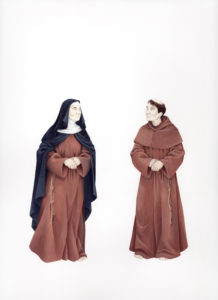Ria Brodell’s Butch Heroes
I search for lesbians in history. There is very little historical record or literature on lesbians before the late 19th century. Imagine my delight in discovering Ria Brodell’s book, Butch Heroes. I am grateful that Brodell found and brought these women to life. I can’t identify with their assumption of a male role; although I certainly can appreciate their brave and adventurous lives.
What is interesting about these individuals is that all of them dressed and assumed a male “role,” i.e., a “butch.” Their lovers or wives assumed a female “role” in the partnership. Did the people in Butch Heroes feel that they needed to identify as a man because they wanted to have sex with other women? Did identifying as a male give them freedom to avoid the female role of keeping house and staying at home? Or both?
What Ria Brodell did with their book is to make an emphatic statement that lesbians, and gender nonconforming people, have always existed, found lovers, lived their lives with varying degrees of success, and some led exceptional lives. Much like today. Society’s degree of toleration has expanded in the last one hundred years, particularly in the past 20 years, but no lesbian or gender nonconforming person lives totally “out” without experiencing some form of violence. Just like the past.
Brodell uses a uniquely Catholic format to portray Butch Heroes. When they/them was growing up their aunt had a huge collection of holy cards, and they would look at them together. She would talk to Brodell about the various saints whose stories were depicted on the cards. “So when I started researching people for Butch Heroes, I immediately thought of holy cards. The way cards employ symbolism, their intimacy, colors, style, etc. was perfect. They elevate a person to reverence. They are used for remembrance. I want this for the Butch Heroes.” 
Ria Brodell started the Butch Heroes project in 2010 after creating the painting, Self Portrait as a Nun or Monk, circa 1250. “I was thinking about what my life would have been like had I been born into a different century. Joining the church, becoming a nun or monk, was one option for those who did not want to enter into a heterosexual marriage or conform to strict gender roles of their time. As a former Catholic, I knew that “homosexuals” were called to a lifetime of chastity or service to the church, but I supposed that queer people of the past must have found other ways to live, and I wanted to find out how they did so.” 
Prior to researching and painting Butch Heroes, Brodell blended sexuality, gender, role models, and Catholic childhood in The Handsome & the Holy, a series of self-portraits and vignettes she created from 2008-2010. “The Handsome & the Holy was the first time I tried to tackle the subject of my gender identity, sexuality and Catholic upbringing through painting,” Brodell said. “As a kid, part of me knew that something was “queer” about who I was attracted to, and who I wanted to be (Cary Grant, Ken, the Prince in all the Disney movies), but I didn’t have the language or the knowledge to understand what that meant. The way I wanted to express my gender did not mesh well with having to wear a little plaid skirt to school.”
Since I owned a Ken doll growing up I know exactly what she meant.
“When I began this series, I remembered a drawing I made for my First Reconciliation book in second grade. I had drawn a picture of St. Michael I was very proud of, and I showed it to my grandma. She told me it looked more like He-Man…Looking back now, He-Man and St. Michael had a similar appeal for me, strong warriors, fighting for good. As far as what unites movie stars, saints and toys like G.I. Joe and He-Man, for me they all represented an ideal, whether it was physical aesthetics or moral values. In combining them all for “The Handsome & the Holy” I was hoping to unite my “queer side” with my religious background because they are equally present in my life.”
One figure I’m surprised Ria Brodell left out was Saint Joan of Arc—who was burned at the stake for dressing like a man and hearing divine voices. I don’t know if she was a lesbian but dressing in armor certainly was outside the gender norms of 13th century French peasant girls.
Another candidate for a future Ria Brodell series would be St. Hildegund of Schonau (d. 1188). St. Hildegund was the daughter of a German knight. When she was twelve, she accompanied her father on a pilgrimage to the Holy Land. For her protection, she was disguised as a boy called Joseph. On the way home her father died. Hildegund/Joseph contained to maintain her identify as a boy then man. Back in Germany, Joseph was admitted to the Cistercian monastery in Schonau, where he remained until his death. 
Buy Butch Heroes here.

